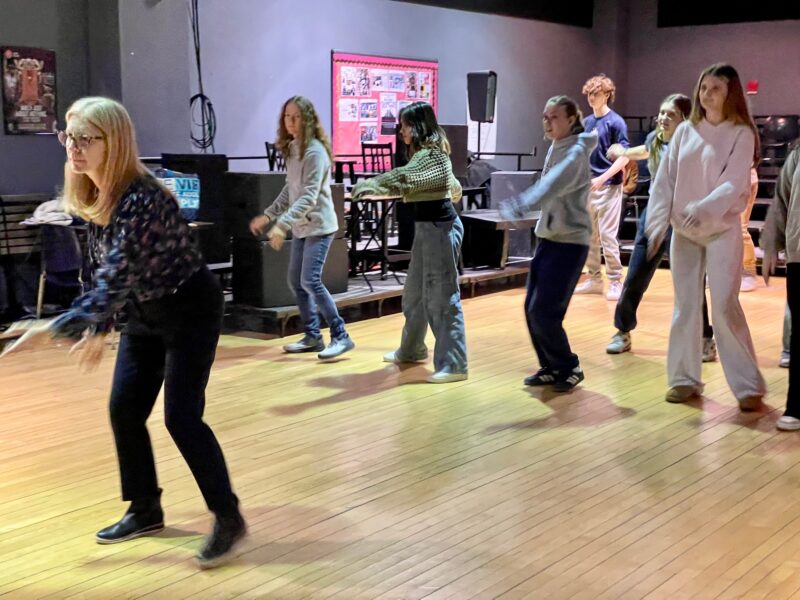Learning French at Princeton High School Involves Some Turns on the Dance Floor
DANCING EN FRANÇAIS: Princeton High School students learn West African dance steps from teacher Janelle Wilkinson, far left, who teaches both French and dance. Making movement a part of the French curriculum provides a unique perspective that students clearly enjoy. (Photo by Sarah Teo)
By Anne Levin
It would make sense to assume that the curriculum of a high school French course is focused on France. But the language is spoken widely in other parts of the world, inspiring Princeton High School (PHS) French teachers Janelle Wilkinson and Gyselle North to broaden the perspective of the classes they teach to three levels of students.
“The French-Speaking World of West Africa” is the theme of the course for French levels 4-6, this month and next. Since Wilkinson also teaches dance at PHS, she has started a unit for the students on West African dance. Last Friday, Wilkinson had students out on the floor of the school’s dance room, learning elements of such dances as the Zaouli from the Ivory Coast, and the Dogon mask dance from Mali — taught all in French, of course.
The students picked up the movements quickly. Taking two steps to the right and two to the left, they followed Wilkinson’s lead as she added some flinging arms and turns in each direction.
“They were very talented,” she said later, referring to the first of three classes taught the dances. “I was kind of surprised at how good they were. The boys, in particular, really impressed me.”
The French 4-6 curriculum focuses on a different Francophone region each year, rotating every three years. Next year is North Africa; the following will be the Americas. The idea is to provide a connection between dancers and ancestors, and dancers and animals, specifically using masks that the students make to embody spirits (the masks weren’t used during the first movement session).
There are numerous types of West African dance, and different ethnic groups have different dances and different styles. Among the dances the students learn in French class is the Sinté from Guinea, which is an individual dance originally performed to inform young adults of the trials they may encounter as they mature, Wilkinson said.
“By exposing our students to a three-year curriculum that focuses on the Francophone world, they will graduate with the knowledge that French is not only spoken in France and Europe, but in many regions all over the world,” Wilkinson wrote in an email. “Learning another language, in general, helps students understand different cultures and perspectives, and learning about the Francophone world, and specifically Africa, will enable our students to become informed and involved global citizens who can think critically.”
Wilkinson said that the unit on West African dance coincides with Black History Month. “While this month is very important for our Black community, we feel strongly at Princeton High School that we celebrate Black history not only during February, but 365 days a year,” she said in an email. “Gyselle and I have reflected this in our year-long curriculum.”
While the students in the first class learning the dances happened to be all white or mixed race, the two other classes are much more racially diverse, she pointed out.
Wilkinson, who grew up in Rochester, N.Y., and danced on cruise ships and in New York before switching her focus to teaching, has been at PHS for 29 years. She started the school’s dance program, which was an immediate hit with students. On average, some 75 to 80 students clamor to take the class, but there is only room for about 60.
“It has evolved into a dynamic class and curriculum, meaning that I change it based on trends and music and student needs and desires,” said Wilkinson. “It’s never static. I have to keep it fresh, for me but most importantly for the students.”
Dance students are immersed in styles ranging from country line dancing to the Charleston, ballet to contemporary, Latin to American barn dance. Wilkinson teaches Michael Jackson’s “Beat It” and “Thriller,” especially around Halloween.
There are some especially rewarding moments.
“I had one student for three years, who came over as an ELL (English Language Learner) from Brazil. She was very shy and quiet,” Wilkinson said. “Dance was a challenge for her. Now, she just volunteered to do two assemblies for me. I would never have guessed that this student would be taking a risk instead of sitting in the corner. Another one, if she could have melted into the wall, she would have been happier. And she had two left feet. After six months, I have watched her become not just a better dancer, but more confident in her body. And she’s socializing. It’s so exciting to see these transformations.”
Merging dance with French was a logical step to take.
“It’s a natural progression,” Wilkinson said. “We learn a lot in [French] class about the arts, whether it’s the music, Impressionism, or maybe a new singer. As a dance teacher, this is my wheelhouse. I teach about dances from different parts of the world. So this was a perfect opportunity, because students learn better by doing. I wouldn’t be able to teach them a song, but I can teach them to do a dance.”


